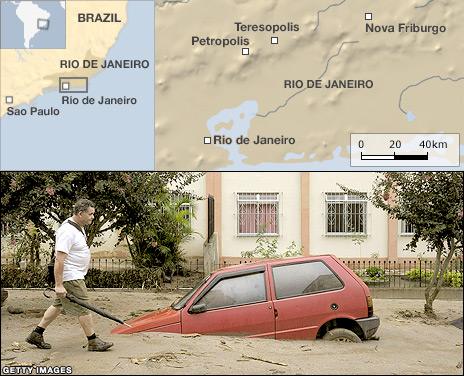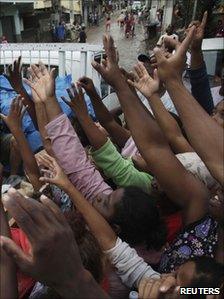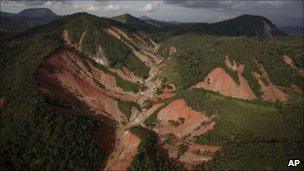Brazil landslides: Military steps up rescue operation
- Published

More than 13,000 people have lost or abandoned their homes because of the disaster
Brazil's military has stepped up rescue and supply operations in areas affected by devastating floods and landslides that have killed at least 655 people.
Seven hundred soldiers have been sent to help emergency personnel in the Serrana area, north of Rio de Janeiro.
Some remote mountainous areas have been cut off for five days, and officials fear they could find more bodies there.
There have been complaints that the authorities have been too slow to bring supplies of water, food and medicines.
Earlier, the Teresopolis city council said it was burying bodies without identifying them first because mortuaries were filled to capacity.
They will collect genetic material to allow bodies to be identified later.
Most of the victims in the alpine district came from the three towns of Nova Friburgo, Teresopolis and Petropolis, with an additional 19 deaths now reported in Sumidouro and four in Sao Jose do Vale do Rio Preto.
In addition, more than 170 people are still missing in Teresopolis and 26 in Petropolis. Nova Friburgo has yet to publish a figure.

"It's impossible to calculate how many people are still buried," the Vice-Governor of Rio de Janeiro state, Luis Fernando Pezao, told the Reuters news agency.
The state has begun seven days of mourning, adding to a three-day national mourning period announced by President Dilma Rousseff.
Disease risk
Heavy rains last week triggered avalanches of earth, rock and water on the steep mountainsides above towns and villages in Serrana.
On Monday, Brazilian army helicopters flew over the area, searching for survivors in the 20 areas cut off by destroyed roads and bridges.
However, pilots said it was treacherous, with jagged mountain peaks, few safe landing zones and a large number of power lines.
"These are the most challenging conditions I've flown in," said Adalberto Ortale of Ibama, the enforcement branch of the Environment Ministry.
Soldiers also began to set up mobile bridges which will allow heavy machinery to move in and begin clearing the tons of mud and debris.
The government says it has supplied hundreds of troops, 8,000 food baskets and seven tonnes of medicine and other supplies, and donations of food and clothing have been coming in from ordinary Brazilians.

Residents say efforts to distribute aid and recover bodies have been slow
But some people have complained that they have been slow to receive basic aid and help searching for the missing.
The authorities have also urged those without reliable supplies of clean drinking water not to resort to drinking run-off water, amid fears of an outbreak of disease.
They are also urging residents and rescue workers to get vaccinated against diseases such as tetanus and diphtheria.
Tents are being flown to the area to house some of the 13,400 people who have lost or abandoned their homes in the disaster.
Risk 'growing'
Experts have gone to the area to assess which parts remain at risk of further landslides so that inhabitants can be evacuated.
Among them is Professor Nelson Fernandes, a geologist at the Geoscience Institute at the Federal University of Rio de Janeiro.
He said both natural and human factors were behind the terrible destruction wrought when a month's worth of rain fell in just eight hours.
The mountainous area has a lot of rocky ground, impervious to water, which creates "avalanches of water" in the valleys, he told the BBC.
But rapid population growth in the area was also responsible, he said - with people building houses on steeply sloping areas and right next to rivers.
He said it was a problem in many parts of the country, particularly at the base of the coastal Serra do Mar mountain range which runs along the coast of much of the country.
"The risk is increasing each year because populations are getting bigger," he said. "Today, almost every landslide will hit something."

Five million Brazilians live in some 800 areas considered at risk of mudslides
The government has been criticised for not alerting people to the dangers.
In November, Brazil's Civil Defence Agency reportedly told the UN that the government had not yet implemented recommendations such as setting up a warning system and investing in infrastructure in at risk areas.
"There is a culture in Brazil of waiting for something to happen and then responding to it," agency head Humberto Vianna was quoted as saying by the Estado de Sao Paulo newspaper.
The Science and Technology Minister, Aloizio Mercadante, said five million people lived in some 800 areas considered at risk of mudslides and floods. He said it would take at least four years for a nationwide alert system to be in place.
- Published15 January 2011
- Published14 January 2011